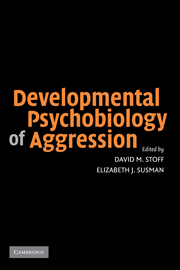Book contents
- Frontmatter
- Contents
- Foreword
- INTRODUCTION
- PART I PLASTICITY
- 2 The Interaction of Biological and Social Measures in the Explanation of Antisocial and Violent Behavior
- 3 Social Deprivation, Social–Emotional Behavior, and the Plasticity of Dopamine Function
- 4 Animal Studies on Inappropriate Aggressive Behavior Following Stress and Alcohol Exposure in Adolescence
- 5 Links Between Girls' Puberty and Externalizing and Internalizing Behaviors: Moving from Demonstrating Effects to Identifying Pathways
- PART II BIDIRECTIONALITY
- PART III GENE–ENVIRONMENT INTERACTIONS
- CONCLUSION
- Author Index
- Subject Index
- References
4 - Animal Studies on Inappropriate Aggressive Behavior Following Stress and Alcohol Exposure in Adolescence
Published online by Cambridge University Press: 14 July 2009
- Frontmatter
- Contents
- Foreword
- INTRODUCTION
- PART I PLASTICITY
- 2 The Interaction of Biological and Social Measures in the Explanation of Antisocial and Violent Behavior
- 3 Social Deprivation, Social–Emotional Behavior, and the Plasticity of Dopamine Function
- 4 Animal Studies on Inappropriate Aggressive Behavior Following Stress and Alcohol Exposure in Adolescence
- 5 Links Between Girls' Puberty and Externalizing and Internalizing Behaviors: Moving from Demonstrating Effects to Identifying Pathways
- PART II BIDIRECTIONALITY
- PART III GENE–ENVIRONMENT INTERACTIONS
- CONCLUSION
- Author Index
- Subject Index
- References
Summary
INTRODUCTION
Violence is a national health problem. Understanding the etiology and pathophysiology that predispose certain individuals to behave in an inappropriate, excessively aggressive way is critical to reducing the incidence of personal violence in the United States. It is clear that traumatic events in early life make children more vulnerable to future stressors and enhance the probability of antisocial behaviors (Luntz & Widom, 1994). Children exposed to early stressful environments and maltreatment prior to kindergarten are more aggressive and have more social problems than control children (Lansford et al., 2002; Sanson, Smart, Prior, & Oberhlaid, 1993). Children exposed to early physical and emotional neglect may develop learning patterns that affect the interpretation of hostile social information, resulting in inappropriate aggressive behavior and general conduct disorder (Dodge, Bates, & Pettit, 1990). Furthermore, children with conduct problems are at risk for alcohol and drug abuse, a predisposition exacerbated by the fact that alcoholism and drug-taking foster antisocial behaviors and violence (Ito, Miller, & Pollock, 1996).
Although psychosocial developmental studies on children have provided insight into the long-term behavioral consequences of early abuse and alcoholism, the biological changes that accompany exposure to these risk factors are not well understood. For ethical reasons, there can be no prospective human studies looking at changes in neurobiology and neuroendocrinology in response to early life traumas. Therefore, biological data must be gleaned from animal studies that try to model certain aspects of the human condition.
- Type
- Chapter
- Information
- Developmental Psychobiology of Aggression , pp. 69 - 86Publisher: Cambridge University PressPrint publication year: 2005



